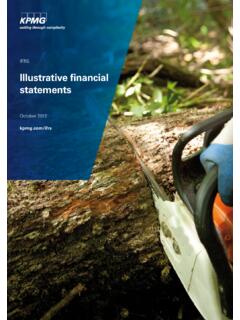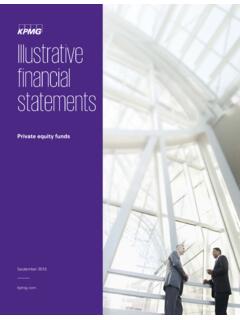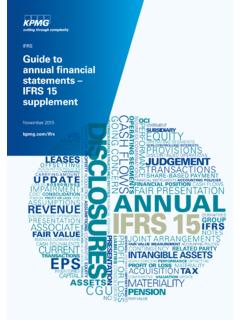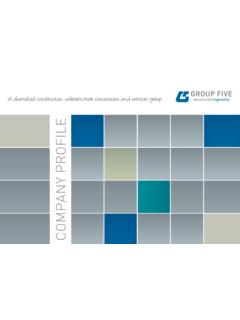Transcription of What does an Integrated Report look like? - KPMG
1 KPMG INTERNATIONAL What does an Integrated Report look like? By Michael Bray, KPMG in Australia and Matt Chapman, KPMG in the UK One of the questions KPMG member firms are most often asked in relation to Integrated Reporting is: what does an Integrated Report look like? Whilst some organizations have made significant progress in applying Integrated Reporting principles, they are all, in our view, still on the journey towards Better Business Reporting. One of the distinguishing features of Integrated Reporting is that in contrast to compliance based reporting, there can be no model Report every Report must be built around the unique business model of the preparer. This requires a very different mindset when looking at examples of good reporting. There are many good illustrations of how to Report specific matters but examples can only provide a starting point for a company s own reporting, not a template.
2 The starting point for understanding how Integrated Reporting works is considering the application of the content elements and guiding principles of the IIRC s Integrated Reporting framework. We have not provided an example of an overall perfect Integrated Report as it simply does not exist at this stage, although the experience in South Africa and the work of the IIRC pilot programme will take us in that direction in the future. What we have done instead is to show the elements that companies need to consider in building up their Integrated Reports, and give some examples of good practice to date. Integrated Reporting building blocks The IIRC has set out the content elements and guiding principles which underlie Integrated Reporting. The Integrated Report should cover the six content elements using the five guiding principles to enable capital providers and other key stakeholders to make decisions about the business s value and stewardship the matters that shape its value for the longer term, its aspirations and plans for the medium-term, the business as it currently stands, and how it has delivered on its promises.
3 Guiding principles for Integrated Reporting Strategic focus Future Orientation Connectivity of information Responsiveness and stakeholder inclusiveness Conciseness, reliability and material It is important to note that whilst the content elements provide a good overall structure, there is no need to assemble the Report in a linear fashion. A consistent thread of key issues should run throughout the Report it should be possible to follow a strategic objective all the way through the Report , from how that objective relates to the business model, through the associated risks and risk mitigation strategies, to the key performance indicators measuring progress in achieving these, and to the future outlook. Applying the Integrated Reporting Content elements YOUR Report READER S NEEDS BUSINESS VALUE ionunerat& Reme ancvernGoGame Changers ess ModelOperating ContextemancPerforValue impact (long-term) BusinStrategyOutlookFuture Management Plans Organisation & (medium-term) Stewardship assessment Report content elements Business As Usual (short-term) What does an Integrated Report look like?
4 / June 2012 Can I model it? Ultimately good reporting is about meeting investors needs. For an Annual Report this comes down to answering two key questions. What does it tell me about the value of the business and what does it tell me about the management s stewardship of the business? Some of the best examples of reporting help readers understand how to model value - how to structure a cash flow model of the business and how to form views on the key model judgments. Businesses that don t do this risk greater capital markets volatility. Tackling Integrated Reporting by element On the following pages we consider each of the six content elements and the challenges that reporters have in addressing them. In doing so, we also highlight how the guiding principles apply across the content elements.
5 We set out the questions reporters need to ask themselves before moving on to give illustrations of good practice. In a publication of this size, we can only cover a limited number of examples: there are many more examples of good out there. Some of these have come from South African public companies that are now preparing their second round of Integrated Reports. Other examples come from companies which have been working to improve their reporting without necessarily seeking to follow the Integrated Reporting principles. Integrating with IFRS and other reporting frameworks Many South African companies are rebranding their annual reports as Integrated annual reports , with Integrated Reporting replacing the front end of the annual Report and IFRS-based financial statements either in the same document or published separately.
6 Existing Annual Report elements such as chairman s statements, CEO reports and operational reviews are being re-focussed on specific Integrated Reporting content elements. Many companies are also continuing to produce GRI-based sustainability reports, usually in a separate publication or on-line. Material information from the financial and sustainability reporting is being retained in the Integrated Report and supplemented with new value-indicating KPIs. Other reporting may be reduced in volume and complexity by the renewed focus that Integrated Reporting can bring. The financial statements of UK company ITV provide an interesting example of how financial statements can be de-cluttered to provide a clearer Report within the existing IFRS framework.
7 In the longer term, Integrated Reporting may become a self-contained, clear and concise articulation of business value and stewardship. Integrated Reporting may be distributed electronically, or even be an electronic repository from which readers can drill down to other reports for detail. Typical approach Structured around Integrated Reporting content elements Retains traditional components (Chairman s statement etc) within the Integrated Reporting framework Incorporates the financial and non-financial data necessary to understand all components of business value No direct change to supporting reports such as the financial statements and corporate responsibility Report (though there may be an opportunity to cut clutter from both) ANNUAL Report FINANCIAL STATEMENTS CORPORATE RESPONSIBILITY OTHER REPORTS 2013 KPMG International Cooperative ( KPMG International ), a Swiss entity.
8 Member firms of the KPMG network of independent firms are affiliated with KPMG International. KPMG International provides no client services. No member firm has any authority to obligate or bind KPMG International or any other member firm vis- -vis third parties, nor does KPMG International have any such authority to obligate or bind any member firm. All rights reserved. Printed in the United Kingdom. 2013 KPMG International Cooperative ( KPMG International ), a Swiss entity. Member firms of the KPMG network of independent firms are affiliated with KPMG International. KPMG International provides no client services. No member firm has any authority to obligate or bind KPMG International or any other member firm vis- -vis third parties, nor does KPMG International have any such authority to obligate or bind any member firm.
9 All rights reserved. Printed in the United does it look like? Organizational overview & business element of the Report provides essential context to the Report user. It provides the foundation on which the more specific disclosures elsewhere in the Report are based. It is also the part of the Report that users will fall back on to assess the headline impact of unexpected events on future cash generation in the absence of any specific management : Is sufficient detail provided to understand the relative importance of each group of assets / activities to the value of the business? Is the analysis sufficient to put the elements of the business into context? Do the components of the business model described link through to the rest of the Report ?
10 The starting point is an explanation of how the business works and the factors which affect the continued operation of the business model. sasol and National Grid are among a growing number of companies that have found a graphical presentation to be high level view of the business model provides a starting point for readers to understand the business on its terms in fact it should be the foundation of the Report . However, it s not enough on its own. Detail is needed if readers are to use the business model description in their decision-making. The right detail will support two different perspectives on the business readers will need both of these when making different judgments about the business:1 Explaining business activity A good description of the business model should provide a basis for explaining each aspect of the business operations the suppliers it interacts with, the inputs on which it depends, the processes it undertakes, the outputs it produces, and the customers it sells to.










